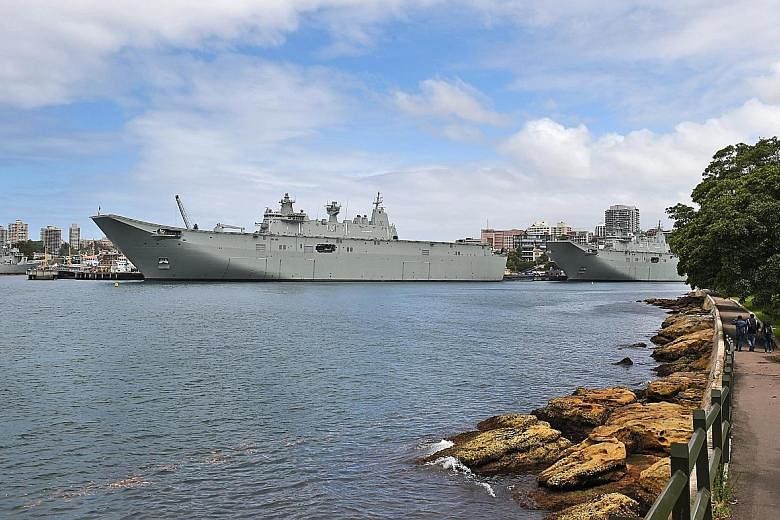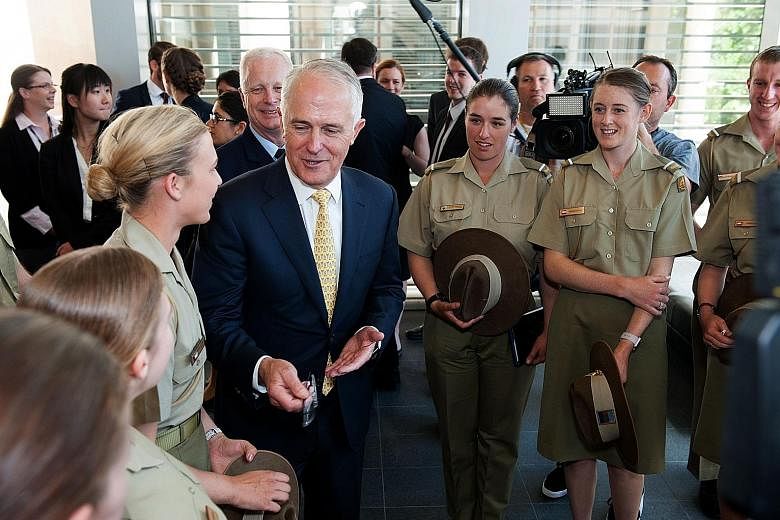Australia will boost defence spending by almost A$30 billion (S$30.2 billion) over the next 10 years as it warns of growing regional tensions and the risk of increasing rivalry between the United States and China.
An ambitious 20-year Defence White Paper released yesterday laid out A$195 billion of spending over the next decade, including plans to start buying a A$50 billion fleet of 12 submarines, as well as new frigates, combat jets and maritime surveillance aircraft.
In a relatively frank assessment of Australia's defence challenges, the White Paper labelled the delicate ties between the US and China as one of the main factors determining the nation's security outlook.
It said the US was Australia's main strategic ally and will remain the pre-eminent global military power, but the relationship between Washington and Beijing "is likely to be characterised by a mix of cooperation and competition".
"While China will not match the global strategic weight of the United States, the growth of China's national power, including its military modernisation, means China's policies and actions will have a major impact on the stability of the Indo- Pacific to 2035," the paper said.
It noted that recent territorial disputes in the East China and South China seas have "created uncertainty and tension in our region".
Prime Minister Malcolm Turnbull said Australia's military needed to be ready in case rivalries and growing military capabilities in the region were to "lead to instability and threaten Australia's interests, whether in the South China Sea, the Korean peninsula or farther afield". He said that other threats included terrorism, cyber warfare and climate change.
"(This) is a plan to become more powerful on land and in the skies, and more commanding both on the seas and beneath them… In the next two decades, half the world's submarines and at least half the world's advanced combat aircraft will be operating in the Indo-Pacific region."
Referring to calls for Australia to conduct freedom-of-navigation operations in the South China Sea, as the United States has done, Mr Turnbull would only say that Australia supports and practises freedom of navigation in accordance with international law, but "we are not going to canvass, forecast future (military) operations".
China reacted angrily yesterday, saying it was "dissatisfied" with "negative" statements about its South China Sea policy.
"We noticed that this White Paper made some remarks about South China Sea and East China Sea. These remarks are negative and we are dissatisfied," China's Foreign Ministry spokesman Hua Chunying said at a regular media briefing.
According to the White Paper, defence spending would rise to 2 per cent of gross domestic product by 2020-2021. A quarter of the extra outlay will be spent on "the most ambitious plan to regenerate the (navy) since World War II".
Analysts largely welcomed the ruling coalition's first White Paper, saying the increased defence spending was necessary.
"For Australia, the era of cheap security is over," Dr Michael Fullilove, executive director of the Lowy Institute, said in an interview on the institute's website.
"In the light of a global order that may well be unravelling and a region that is increasingly troubled in security terms, I think Australia needs a more capable, muscular Australian Defence Force."
However, some analysts said Australia had not done enough to build up the military, given its own blunt warnings about the growing regional and global challenges.
The Defence White Paper called on Australia to expand international cooperation, including with Singapore, with which it has "a long history of defence engagement".
The paper also warned that the terror threat to Australia was growing and that climate change will be a "major challenge" in the region.


